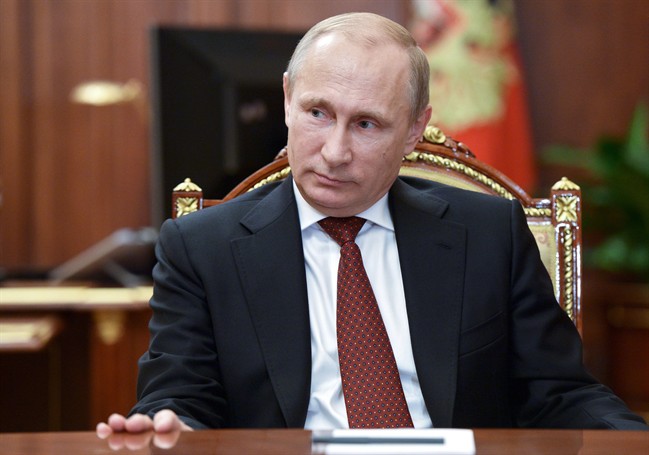MOSCOW – Russia identified NATO as the nation’s No. 1 military threat and raised the possibility of a broader use of precision conventional weapons to deter foreign aggression under a new military doctrine signed by President Vladimir Putin on Friday.

NATO flatly denied it was a threat to Russia, and accused Russia of undermining European security.
The new doctrine, which comes amid tensions over Ukraine, reflected the Kremlin’s readiness to take a stronger posture in response to what it sees as the U.S.-led efforts to isolate and weaken Russia.
The paper maintains the provisions of the previous, 2010 edition of the military doctrine regarding the use of nuclear weapons.
READ MORE: Ukraine prisoner exchange underway, around 370 expected to be released
It says Russia could use nuclear weapons in retaliation to the use of nuclear or other weapons of mass destruction against the country or its allies, and also in the case of aggression involving conventional weapons that “threatens the very existence” of the Russian state.
But for the first time, the new doctrine says Russia could use precision weapons “as part of strategic deterrent measures,” without spelling out when and how Moscow could resort to them.
Examples of precision conventional weapons include ground-to-ground missiles, air- and submarine-launched cruise missiles, guided bombs and artillery shells, among other systems.
Among other provisions, the paper mentions the need to protect Russia’s interests in the Arctic, where the global competition for vast oil and rich resources has been heating up as the Arctic ice melts.
- U.S. tourist faces 12-year sentence for bringing ammo to Turks and Caicos
- Canada refused to repatriate woman from ISIS camp because she can’t be arrested: internal memo
- Tabloid publisher tells trial he bought, squashed stories damaging to Trump
- Aw, rats: Chicago’s beloved ‘Rat Hole’ removed from sidewalk
READ MORE: Syrian peace talks tentatively set to take place in Moscow next month
Russia has relied heavily on its nuclear deterrent and lagged far behind the U.S. and its NATO allies in the development of precision conventional weapons. However, it has recently sped up its military modernization, buying large numbers of new weapons and boosting military drills.
NATO has said that a sharp rise in the number of Russian air patrols over the Baltics has put civilian flights at risk.
Earlier this month, Russia flexed its muscle by airlifting the state-of-the art Iskander missiles to its westernmost Kaliningrad exclave bordering NATO members Poland and Lithuania. The missiles were pulled back to their home base after the drills, but the deployment clearly served as a demonstration of the military’s readiness to quickly raise the ante in case of crisis.
Russia has threatened earlier that it could permanently station the Iskander missiles, which can hit targets up to 480 kilometres (about 300 miles) away with high precision, in retaliation to U.S.-led NATO missile defence plans. Iskander missiles can be fitted with a nuclear or conventional warhead.
On Friday, the military successfully test-fired the RS-24 Yars intercontinental ballistic missile from the Plesetsk launchpad in northwestern Russia.
The 29-page doctrine is a stand-alone document outlining top threats to Russia’s security and possible responses. The current edition is the third since Putin was first elected in 2000.
The doctrine placed “a buildup of NATO military potential and its empowerment with global functions implemented in violation of international law, the expansion of NATO’s military infrastructure to the Russian borders” on top of military threats to Russia.
It stressed that that the deployment of foreign military forces on the territory of Russia’s neighbours could be used for “political and military pressure.”
NATO spokeswoman Oana Lungescu responded by saying in a statement that the alliance “poses no threat to Russia or to any nation.”
“Any steps taken by NATO to ensure the security of its members are clearly defensive in nature, proportionate and in compliance with international law,” she said. “In fact, it is Russia’s actions, including currently in Ukraine, which are breaking international law and undermining European security.”
Russia’s relations with the West have plummeted to their lowest level since Cold War times, and NATO cut off ties with Moscow after it annexed Ukraine’s Crimean Peninsula in March. Ukraine and the West also have accused Moscow of fueling a pro-Russia insurgency in eastern Ukraine with troops and weapons, accusations the Kremlin has denied.
“NATO will continue to seek a constructive relationship with Russia, as we have done for more than two decades,” Lungescu said.
“But that is only possible with a Russia that abides by international law and principles – including the right of nations to choose their future freely.”
Former Soviet President Mikhail Gorbachev, who had been critical of Putin in the past, but who has strongly backed the Kremlin over its spat with the West, said Friday that Russia’s actions were a response to U.S. and NATO moves.
“I think the president is right to a large extent when he draws attention to a particular responsibility of the United States,” he said during a presentation of his book in Moscow.
The U.S. and the European Union have slapped sanctions against Moscow, which have deepened Russia’s economic woes and contributed to a sharp devaluation of the ruble, which lost about half of its value this year.
The economic crisis could challenge Russia’s ambitious weapons modernization program, but so far the Kremlin has shown no intention of scaling it back.
The program envisages the deployment of new nuclear-tipped intercontinental ballistic missiles, the construction of nuclear submarines and a sweeping modernization of Russia’s conventional arsenals.
Russia has been particularly concerned about the so-called Prompt Global Strike program under development in the U.S., which would be capable of striking targets anywhere in the world in as little as an hour with deadly precision.
The new doctrine mentioned the U.S. program as a major destabilizing factor along with NATO missile defence plans.
Russian officials have said that Moscow was working on a response to the new U.S. weapons, but have released no details.
Alexander Konovalov, a Moscow-based independent military expert, said the doctrine’s mention of using precision conventional weapons as a “strategic deterrent” sounds vague, but could be a reference to new weapon designs.
“It may mean the development of weapons systems, which would make it impossible for NATO to plan a surprise first strike, because it would draw a powerful retaliation,” he said. “It would allow (Russia) to enforce its will on the enemy without using nuclear warheads.”
—
John-Thor Dahlburg in Brussels contributed to this report.



Comments